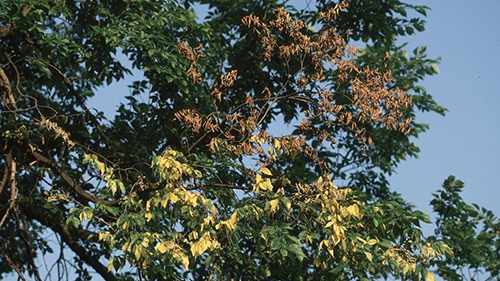Elm trees in New Zealand are an important feature of many urban and rural landscapes and have significant amenity and heritage value.
Dutch elm disease (DED) is caused by two species of fungus (Ophiostoma ulmi and O. novo-ulmi) and is considered one of the most devastating tree diseases in the world. It can be spread by tiny elm bark beetles from elm to elm, via the trees’ root systems, movement of firewood or by contaminated pruning tools. The fungus blocks the elm’s water and nutrient conducting system. An infected elm tree can die in as little as three weeks or over a period of two to three years.
DED is in the Waikato region
DED was first identified in New Zealand in 1989, in central Auckland, where it has caused the death of many elms. Auckland Council has been undertaking an ongoing programme to manage DED and prevent its spread to the rest of New Zealand. Unfortunately, in 2021, DED was discovered to have spread into the north Waikato and it has currently spread as far south as Huntly.
 European elm bark beetle (Scolytus multistriatus). Photo: Gerald J. Lenhard, United States
European elm bark beetle (Scolytus multistriatus). Photo: Gerald J. Lenhard, United States
 Characteristic staining on a cross section of elm branches. Photo: Darryn Horrell
Characteristic staining on a cross section of elm branches. Photo: Darryn Horrell
Symptoms
Symptoms develop quickly within a four-to-five week period.
Early symptoms include wilting and/or yellowing leaves on the tip of a branch and then turning brown and curling up. The leaves are usually retained on the branch for some time. These symptomatic branches are called flags, and their appearance in an otherwise healthy crown is called flagging.
As the disease progresses, more flags will appear until the whole crown becomes symptomatic. Other, more diagnostic symptoms of DED include a brown to black streaking or discoloration under the outer bark of infected branches. However, only a trained diagnostician can confirm the presence of DED by conducting specific laboratory tests.
 An infected elm tree can die in as little as three weeks.
An infected elm tree can die in as little as three weeks.
 Flagging on an elm tree. Photo: Joseph O’ Brien, USDA Forest Service
Flagging on an elm tree. Photo: Joseph O’ Brien, USDA Forest Service
Affected species
Most Ulmus species from Europe and North America are highly susceptible to DED. Some Asian elms have a greater level of resistance. DED has been recorded on the genus Zelkova but it is highly resistant.
Spread
A key vector for the spread of DED is the European elm bark beetle, Scolytus multistriatus. Over winter, these beetles as adults or larvae tunnel into elm trees. The fungus that causes DED in the wood of infected, dying trees produces spores in the bark beetles’ tunnels. The beetles may pick up the spores as they move through the tunnels. The fungal spores are then spread to healthy trees when the adult beetles emerge in spring and summer, fly to healthy trees and feed on the twigs. Infected beetles can also move to new areas in infested timber (especially where the bark is retained) used for furniture, firewood or wood chips.
Root grafts commonly form between closely planted elm trees, especially elms of the same species. DED fungi can spread from diseased trees to healthy trees by these grafts. The fungus can kill an entire avenue of trees in this way.
The disease may be spread via elm nursery stock. Elm flowers (fresh) and bark on timber, chips and handicrafts can also carry the pathogen. It is possible that DED pathogens can be spread on non-disinfected pruning tools.

Drawing showing cycle of disease. Drawing: Vickie Brewster
Management
There is no known cure for DED-infected elm trees.
Management of the disease includes the following.
- Rapid disease identification and removal of all infected trees. Wood from felled elm trees should be immediately chipped, burnt or buried on site, or buried at a landfill site. If chipped it must be left on-site for at least three months.
- Physically destroying root grafts between adjacent trees. Destroy root grafts before infected trees are removed.
DED is a notifiable organism under the Biosecurity Act 1993.
If you suspect DED, please report it to MPI’s Exotic Pest and Disease Hotline on 0800 80 99 66.


